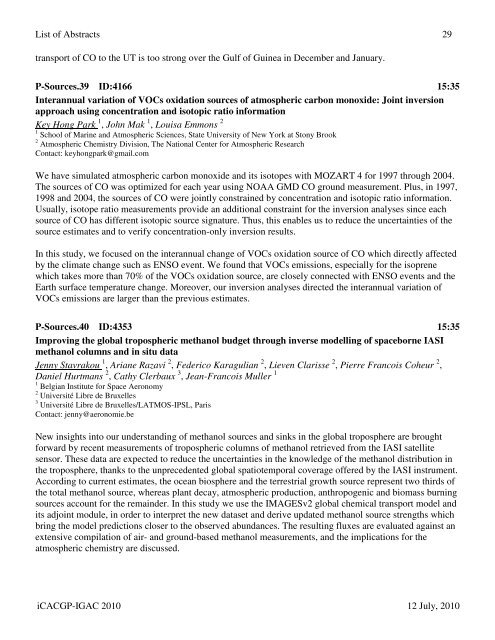Download Abstracts Here - IGAC Project
Download Abstracts Here - IGAC Project
Download Abstracts Here - IGAC Project
Create successful ePaper yourself
Turn your PDF publications into a flip-book with our unique Google optimized e-Paper software.
List of <strong>Abstracts</strong> 29transport of CO to the UT is too strong over the Gulf of Guinea in December and January.P-Sources.39 ID:4166 15:35Interannual variation of VOCs oxidation sources of atmospheric carbon monoxide: Joint inversionapproach using concentration and isotopic ratio informationKey Hong Park 1 , John Mak 1 , Louisa Emmons 21 School of Marine and Atmospheric Sciences, State University of New York at Stony Brook2 Atmospheric Chemistry Division, The National Center for Atmospheric ResearchContact: keyhongpark@gmail.comWe have simulated atmospheric carbon monoxide and its isotopes with MOZART 4 for 1997 through 2004.The sources of CO was optimized for each year using NOAA GMD CO ground measurement. Plus, in 1997,1998 and 2004, the sources of CO were jointly constrained by concentration and isotopic ratio information.Usually, isotope ratio measurements provide an additional constraint for the inversion analyses since eachsource of CO has different isotopic source signature. Thus, this enables us to reduce the uncertainties of thesource estimates and to verify concentration-only inversion results.In this study, we focused on the interannual change of VOCs oxidation source of CO which directly affectedby the climate change such as ENSO event. We found that VOCs emissions, especially for the isoprenewhich takes more than 70% of the VOCs oxidation source, are closely connected with ENSO events and theEarth surface temperature change. Moreover, our inversion analyses directed the interannual variation ofVOCs emissions are larger than the previous estimates.P-Sources.40 ID:4353 15:35Improving the global tropospheric methanol budget through inverse modelling of spaceborne IASImethanol columns and in situ dataJenny Stavrakou 1 , Ariane Razavi 2 , Federico Karagulian 2 , Lieven Clarisse 2 , Pierre Francois Coheur 2 ,Daniel Hurtmans 2 , Cathy Clerbaux 3 , Jean-Francois Muller 11 Belgian Institute for Space Aeronomy2 Université Libre de Bruxelles3 Université Libre de Bruxelles/LATMOS-IPSL, ParisContact: jenny@aeronomie.beNew insights into our understanding of methanol sources and sinks in the global troposphere are broughtforward by recent measurements of tropospheric columns of methanol retrieved from the IASI satellitesensor. These data are expected to reduce the uncertainties in the knowledge of the methanol distribution inthe troposphere, thanks to the unprecedented global spatiotemporal coverage offered by the IASI instrument.According to current estimates, the ocean biosphere and the terrestrial growth source represent two thirds ofthe total methanol source, whereas plant decay, atmospheric production, anthropogenic and biomass burningsources account for the remainder. In this study we use the IMAGESv2 global chemical transport model andits adjoint module, in order to interpret the new dataset and derive updated methanol source strengths whichbring the model predictions closer to the observed abundances. The resulting fluxes are evaluated against anextensive compilation of air- and ground-based methanol measurements, and the implications for theatmospheric chemistry are discussed.iCACGP-<strong>IGAC</strong> 2010 12 July, 2010








